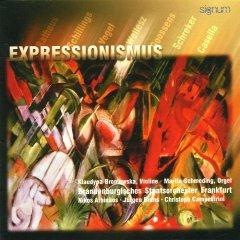Expressionismus - Casella, Goossens, Schreker, Rathaus, Schillings, Vogel, Wellesz (2002)
Expressionismus - Casella, Goossens, Schreker, Rathaus, Schillings, Vogel, Wellesz (2002)

Disc: 1 Alfredo Casella 1. Elegia eroica, for orchestra, Op. 29 Eugene Goosens 2. Suite From Kaleidoscope, for orchestra, Op. 18: Good morning 3. Suite From Kaleidoscope, for orchestra, Op. 18: Promenade 4. Suite From Kaleidoscope, for orchestra, Op. 18: Hurdy-Gurdy-Man 5. Suite From Kaleidoscope, for orchestra, Op. 18: March of the Wooden Soldier 6. Suite From Kaleidoscope, for orchestra, Op. 18: Lament for a Departed Doll 7. Suite From Kaleidoscope, for orchestra, Op. 18: The Old Musical Box 8. Suite From Kaleidoscope, for orchestra, Op. 18: The Punch and Judy Show 9. Suite From Kaleidoscope, for orchestra, Op. 18: Good-night Franz Schreker 10. Fantastic Overture, Op.15 Karol Rathaus 11. Suite for violin & orchestra, Op. 27: Bewegt und wuchtig 12. Suite for violin & orchestra, Op. 27: Andante 13. Suite for violin & orchestra, Op. 27: Maestoso 14. Suite for violin & orchestra, Op. 27: Allegro Max von Schillings 15. Symphonic Prologue to King Oedipus, Op 11 Disc: 2 Karol Rathaus 1. Ouvertüre for orchestra, Op. 22 Wladimir Vogel 2. Etüden (2) for orchestra: Ritmica funebre 3. Etüden (2) for orchestra: Ritmica scherzosa Egon Wellesz 4. Vorfrühling, for orchestra, Op. 12 Alfredo Casella 5. Concerto Romano for organ, brass, timpani & string orchestra, Op 43: Sinfonia: Lento, grave 6. Concerto Romano for organ, brass, timpani & string orchestra, Op 43: Largo 7. Concerto Romano for organ, brass, timpani & string orchestra, Op 43: Cadenza e Toccata: Allegro agitato ed impetuoso Brandenburgisches Staatsorchester Frankfurt Nikos Athinäos, Jürgen Bruns and Christoph Campestrini – conductors Klaudyna Broniewska – violin (CD1 tracks: 11-14) Martin Schmeding – organ (CD2 tracks: 5-7)
The music of 7 (very) different composers is presented here, in well recorded and enthusiastic performances. Four stars for the one five star work here, the Concerto Romano by Alfredo Casella. The Concerto Romano does not seem to have been recorded yet by Naxos or Chandos in their respective Casella series, but until it is, this one will do fine. Disregard the collections name, there is no really expressionistic music here, nothing like early Schoenberg. Max von Schillings (at least here) sounds like a standard (and accomplished) Romantic. Casella of course was best known as a Neoclassicist . The Goossens piece is lightweight entertainment. The others may come closer to that label but there are no cries of anguish. --- Alan Zelaya, amazon.com
Expressionism in music, which crested between the two world wars, gave voice to the anxieties, inner terrors, and cynicism of human life in the 20th century through emotionally intense, musically complex, and carefully structured works. Conventional techniques were distorted, and "pretty" harmonies were avoided in favor of dissonant, complex ones used with great power. The music is often atonal or distorts traditional tonality. Polyphony (interweaving of melodic lines) is often dense, and melody in the traditional sense is often unrecognizable.
The roots of expressionism can be seen in the works of late romantic composers such as Richard Wagner of Germany, and in the compositions of postromantics such as the Austrian composer Gustav Mahler. Examples include two early operas by the German composer Richard Strauss, Elektra (1909) and Salome (1905); certain works of the Austrian composer Arnold Schoenberg, the dramatic scenes Erwartung (Anxiety, 1909) and Die Glückliche Hand (The Lucky Hand, 1913), and the song cycle Pierrot Lunaire (1912); and the operas of the Austrian composer Alban Berg, Wozzeck (1925) and Lulu (1935; first full performance, 1979). Other composers with expressionist elements include Paul Hindemith of Germany, Béla Bartók of Hungary, and Sergey Prokofiev of Russia. --- autocww.colorado.edu
download (mp3 @320 kbs):
yandex 4shared mega mediafire cloudmailru uplea








